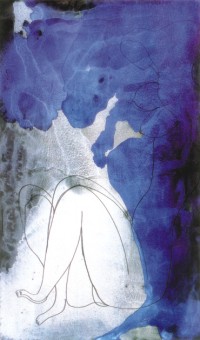|
Letters
Voicebox
Chintito
Cover Story
News Notes
Business
Musings
Time Out
Human Rights
Food For Thought
International
In Retrospect
Exhibition
Achievement
Environment
Lifestyle
Education
Sci-tech
Dhaka Diary
Health
Jokes
Book Review
Books
New Flicks
Trivia
SWM Home
|
|
Exhibition

Relation-4,
tempera, 2005 |
The
Natural In Humans
Mustafa
Zaman
The
primordial in all its visual glory, this may sum up the world
of Rokeya Sultana. And to express the primordial, colour, it
seems at first glance, is her main proposition. The rest gradually
surfaces as the shocks of blue, brown, red and yellow give way
to suggestive human forms and other elements that are relegated
to secondary stimulants.
Colours come in various shades
in her work and humans are embodied in their simplest of forms
-- child-like, yet having a presence that speaks of the symbiotic
relationship they have with nature. What is natural to man,
the symbiosis as well as the beauty, is what makes Rokeya
lay out her imagery sometimes in unusual colour combinations:
brown with blue, red with moss green. Sometimes the conventional
combination of red and yellow or burnt sienna is used to its
full potential. Though colourful, her paintings seems unobtrusive
to the eyes. They are quiet but not as quiet as a painting
by Mohammed Kibria, one of Rokeya's favourite artists.
Her works gives off a sense
drawn from a certain engagement with life and nature. This
sense or sensibility stirs into action in most of her work.
She is best when she is searching for a place for her humans
mostly women in her canvases. Humans to her is an integral
part of nature, they even mutate into more sensual forms.
That Rokeya is free from representational fidelity is something
that stems from the attitude she has towards her humans as
well as nature . "I try to capture what is transcendental
in man and nature," explains the artist. And her recent
solo at the Bengal Gallery of Fine Arts is aptly titled, "Dreams
of the Elusive."

Relation-23,
tempera, 2005. |
The symbiotic relationship
of humans with nature is the focal point in her work. And
to emphasise this she presents them in the simplest of forms.
"It is only after I have become an accomplished draughtsman
that I have veered towards such drastic simplicity of drawings,"
says the artist. She is emphatic about the fact that in order
to try out transformation that brings down the forms to its
bare minimum one needs to have a good academic background.
"Without the ability to represent reality one cannot
go to such extent," she adds.
Rokeya's forays represent
the inner makeup of a mind that craves to go beyond the bounds
of social structures. Perhaps that is why she seeks to revive
the communion of humans with nature. The sense of pantheism
that flows like currents through most of her works is not
forced. They are an expression of the creator's mind. The
spontaneity is evident in most of her tempera on canvas works.
Both in execution and thought, she is free of any academic
constraints. However, the laws of abstract expressionism sometimes
do get in her way.
Inspired as she is by the
formalist idiom, most of her works do bring into existence
an atmospheric, and at times, expressionistic attitude.

Relation-3,
tempera, 2004. |
Rokeya is prolific, in her
late 40s, she picks up the brush everyday "even to put
a dab of paint on a canvas." Her steadfastness has paid
her dividend. She went through phases in both subject matter
and mediums. There, in fact, had been three phases in her
career as far as her subject is concerned.
At one stage, after completing
her masters in 1983 in Printmaking from Visva Bharati, Santiniketan,
she had a fixation on sceneries. Later her madonna, a series
depicting a mother with her child, gave her the prominence
she deserved. However, her third phase is characterised by
female duos, couples and lone women in the midst of nature.
In her previous solo at Bengal Gallery in 2001, her attention
turned to "Water, Earth, Wind," and that was the
occasion when the artist as a mother of one daughter, came
of age; she started acknowledging her child as a grown woman.
" In my recent paintings
I often depict two women. It has to do with the fact that
I now consider my own child as a companion. And as for woman
I depict her as all - consuming and all - conquering,"
relates Rokeya, hence the projection of women as a natural
force in her art.
The emotive force is what
Rokeya tries to employ behind her drawings of figures and
it renders them child-like. As for the atmosphere that her
works thrives on, it is the result of the way she applies
tempera, conventionally used as oil-based medium. Rokeya has
been using it with water for the last decade or so, and at
present it is the water colour-like application that lends
her works the signature brio.
Copyright
(R) thedailystar.net 2005
|
|
